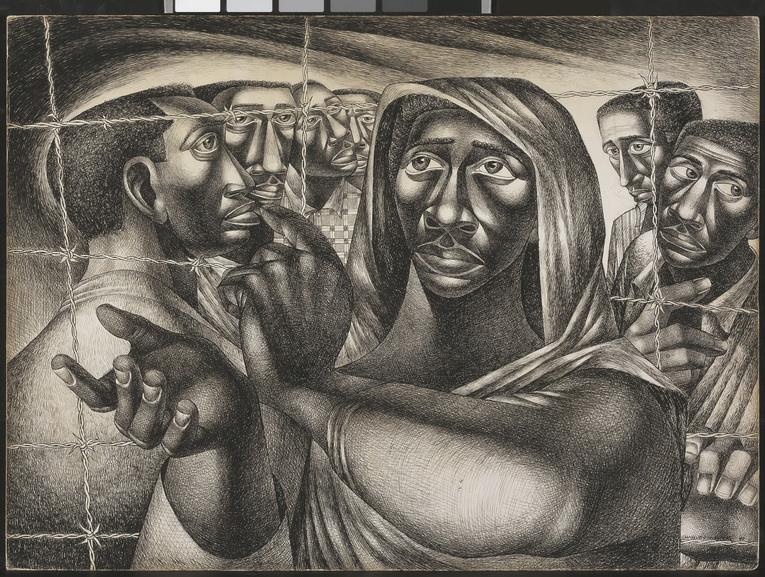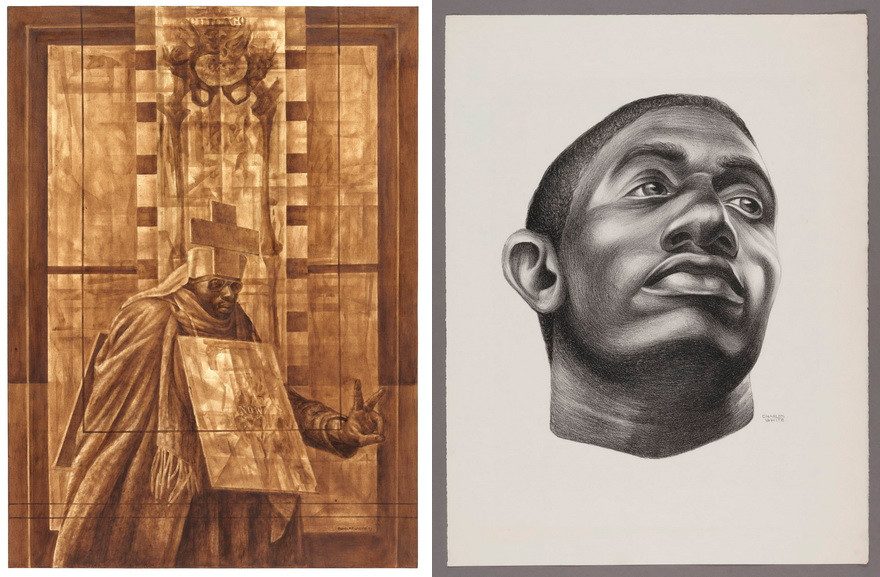[ad_1]
Certain figures from the art world are unevenly represented and such a situation always reflects certain social or even political implications. Despite the flow of time and the demands of an art market for the undiscovered or rarely represented art, the oeuvres of particular artists are still not that known to the wider audience. Such is the case of Charles White.
Besides being an artist, Charles White was an established lecturer and one of the significant advocates of Black Arts Movement and later the Human Rights movement. He came to prominence in the late 1930s, just after the Great Depression. He was persistent to learn the African American History and those lessons largely affected his artistic practice.
It is important to point out that the period was very much marked by the segregation and the racial hatred, so to become an artist as a person of color meant a great deal, as it required a lot of persistence, focus, and compromises.
In order to reevaluate the domains and the significance of his practice for this particular purpose, the curators Esther Adler and Sarah Kelly Oehler have gathered around 100 works ranging in media from drawings, paintings, through prints over to photographs for upcoming retrospective at The Art Institute of Chicago, and later at the Museum of Modern Art in New York as well, which is not only a detailed survey of White’s work, but it will also provide an important insight into the changing circumstances of the American society in the span of four decades.

Charles White and The Importance of African American Heritage
Charles Wilbert White was born in a poor working-class family and during his childhood, he spent much time in a library while his parents worked and were very much encouraged to absorb arts (music lessons, theater groups, etc). White was also a frequent visitor of The Art Institute in Chicago, but due to bad financial conditions, he also had to work.
Nevertheless, he learned to paint and used practically any surface to express himself. In his formative years, White became extremely interested in the African American history, and the critique of the Harlem Renaissance titled The New Negro by Alain Locke was of great importance for his social believes.
Despite the difficulties within the educational system, he received various scholarships (which were often given away to a white child instead of him), the most important being the one by the Art Institute of Chicago of which he became a full-time student.
Later, White started working as an art teacher at St. Elizabeth Catholic High School to pay for the costs, and he also became a Works Progress Administration artist. Interestingly so, he was even jailed for forming a union with fellow black artists who were being treated unfairly.
In 1941, he moved to New Orleans where he taught at Dillard University and married a famed artist Elizabeth Catlett. White was also teaching at the Otis Art Institute from 1965 to his death in 1979.

The Installment And The Significance of The Exhibition
The installment is a based on the chronological order so that each phase can be understood properly. The groupings are centered on the cities and creative communities in which White lived and worked, and each of them is followed by relevant ephemera and documentary materials detailing his working process, political and social activities, and role as a teacher.
The whole constellation reveals Charles White’s enormous capability to explore and absorb various techniques and styles from contemporary art and culture and a precise interpretation of political climate. Namely, the artist’s approach to figuration reflects how he perceived art as the perfect tool for addressing social and political issues. The best example for this conclusion is the work The Contribution of the Negro to American Democracy, a large scale mural at Hampton University. It is a group composition and depicts a number of important figures from the Black history including Harriet Tubman, Marian Anderson, Nat Turner and others.

Charles White at AIC and MoMA
The Charles White exhibition will be accompanied by an extensive catalog which will feature rich illustrations as well as essays by curators Deborah Willis, University Professor and Chair of the Department of Photography & Imaging at the Tisch School of the Arts at New York University and Kellie Jones, Associate Professor in Art History and Archaeology and the Institute for Research in African American Studies (IRAAS) at Columbia University, and. It is important to add that MoMA also published the book titled Charles White: Black Pope, which provides the reader a thorough insight into White’s practice and a deep analysis of the drawing Black Pope (1973).
Charles White: A Retrospective is organized by the Museum of Modern Art and The Art Institute of Chicago. The exhibition will be on view at the Art Institute of Chicago from 8 June until 3 September and will be moved to The Museum of Modern Art from 7 October until 13 January 2019. Finally, in Spring 2019 it will be on view at the Los Angeles County Museum of Art.
Editors’ Tip: Charles White: A Retrospective
Charles White (1918–1979) is best known for bold, large-scale paintings and drawings of African Americans, meticulously executed works that depict human relationships and socioeconomic struggles with a remarkable sensitivity. This comprehensive study offers a much-needed reexamination of the artist’s career and legacy. With handsome reproductions of White’s finest paintings, drawings, and prints, the volume introduces his work to contemporary audiences, reclaims his place in the art-historical narrative, and stresses the continuing relevance of his insistent dedication to producing positive social change through art.
Featured image: Charles White – Harvest Talk, 1953. The Art Institute of Chicago. Restricted gift of Mr. and Mrs. Robert S. Hartman. © The Charles White Archives Inc. All images courtesy The Art Institute of Chicago.
[ad_2]
Source link
